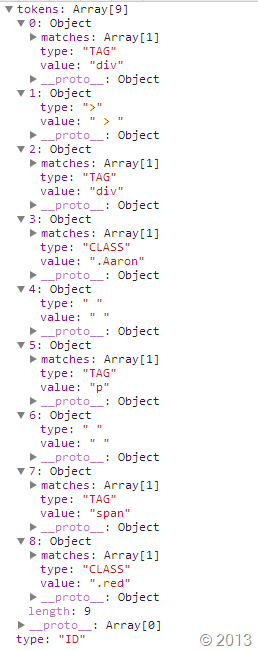tokenize源码备注:
Sizzle.tokenize//2131行
rcomma = new RegExp( "^" + whitespace + "*," + whitespace + "*" ) //601行
whitespace = "[\\x20\\t\\r\\n\\f]" //574行
\t:水平制表符 \f:换页符 \r:回车符 \n:换行符 \x20:空格符
rcombinators = new RegExp( "^" + whitespace + "*([>+~]|" + whitespace + ")" + whitespace + "*" ),
rcombinators = /^[\x20\t\r\n\f]([>+~]|[\x20\t\r\n\f])[\x20\t\r\n\f]/ 零个或多个WS+捕获(>;+;~|WS)+零个或多个WS
rtirm = new RegExp( "^" + whitespace + "+|((?:^|[^\\\\])(?:\\\\.)*)" + whitespace + "+$", "g" ),
rtirm = /^[\x20\t\r\n\f]+|((?:^|[^\])(?:\.)*)[\x20\t\r\n\f]+$/g
注: (?:exp)匹配exp,不捕获匹配的文本,也不给此分组分配组号
\x?? 表达的意思
这是利用2位16进制表示ascii码表中的字符。
而\uxxxx是利用4位十六进制表示Unicode字符。
选择器解析基本思想
解析结果:

我们可以看到:选择器被分解成了数组里的多个token对象 token对象的格式如下:
Token:{
value:'匹配到的字符串',
type:'对应的Token类型',
matches:'正则匹配到的一个结构'(捕获组)
}
如果选择器的格式是以逗号分割的多个选择器,则返回一个二维数组,这个数组的每一项都是一组token对象。
tokenize函数思想:
function tokenize( selector, parseOnly ){
var matched, match, tokens, type,
soFar, groups, preFilters, //soFar:全局变量,用来放置解析的选择器字符串,会随着程序的运行不断削减。
cached = tokenCache[ selector + " " ]; //从缓存中读取已经解析好的选择器。
while(soFar){
if(匹配到逗号)//表示是一个新的选择器了
{
新建一个数组,用来放置一组新的token
去掉soFar中匹配的部分
}
if((match = rcombinators.exec( soFar ))) //匹配+>~
{
tokens.push({
value: matched,
// Cast descendant combinators to space
type: match[0].replace( rtrim, " " ) //感觉rtrim在这里用处不大,因为match[0]只有四种可能+>~空格
});
}
for(type in Expr.filter)//Expr.filter中有这些类型TAG,CLASS,ATTR,CHILD,PSEUD,进行循环匹配
{
if ( (match = matchExpr[ type ].exec( soFar )) && (!preFilters[ type ] ||
(match = preFilters[ type ]( match ))) ) {
matched = match.shift();
//放入Token序列中
tokens.push({
value: matched,
type: type,
matches: match
});
//剩余还未分析的字符串需要减去这段已经分析过的
soFar = soFar.slice( matched.length );
}
}
if ( !matched ) { //到此没有匹配完说明有问题
break;
}
return parseOnly ? //如果是只解析,抛出soFar长度,如果长度>0表示解析失败,其他情况,如果soFar长度不为零,抛出Sizzle错误。否则将解析的选择器结果缓存以便下次调用。
soFar.length :
soFar ?
Sizzle.error( selector ) :
// Cache the tokens
tokenCache( selector, groups ).slice( 0 );
}
}
缓存tokenCache
tokenCache在tokenize函数的开头与结尾被调用到:
cached = tokenCache[ selector + " " ]; //从缓存中读取已经解析好的选择器。
tokenCache( selector, groups ).slice( 0 ); //将选择器名作为键,解析的结果作为值压入缓存
第540行有tokenCache的创建过程,可以发现,除了tokenCache,还有其他的缓存也是通过一个名为createCache的函数创建的
classCache = createCache(),
tokenCache = createCache(),
compilerCache = createCache(),
在854行我们可以看到createCache
function createCache() {
var keys = [];
function cache( key, value ) {
// Use (key + " ") to avoid collision with native prototype properties (see Issue #157)
if ( keys.push( key + " " ) > Expr.cacheLength ) {
// Only keep the most recent entries
delete cache[ keys.shift() ];
}
return (cache[ key + " " ] = value);
}
return cache;
}
这是一个创建函数的函数,它创建的函数cache既能作为函数调用,又能作为对象来储存缓存,因为js中函数也是一个对象,一个函数被创建之初除了获得一个prototype属性指向一个空对象之外,它本身也可以作为对象而挂载属性。当cache被赋值给takenCache时,形成了一个闭包,tokenCache可以通过闭包访问keys,并向其中push键名。key+' '用来避免属性名与原生属性名冲突,return (cache[ key + " " ] = value)最后会返回value。这相当于cache[ key + " " ] = value;return value;
createCache函数非常值得学习。
/**
*
*
*matchExpr 过滤正则
ATTR: /^\[[\x20\t\r\n\f]*((?:\\.|[\w-]|[^\x00-\xa0])+)[\x20\t\r\n\f]*(?:([*^$|!~]?=)[\x20\t\r\n\f]*(?:(['"])((?:\\.|[^\\])*?)\3|((?:\\.|[\w#-]|[^\x00-\xa0])+)|)|)[\x20\t\r\n\f]*\]/
CHILD: /^:(only|first|last|nth|nth-last)-(child|of-type)(?:\([\x20\t\r\n\f]*(even|odd|(([+-]|)(\d*)n|)[\x20\t\r\n\f]*(?:([+-]|)[\x20\t\r\n\f]*(\d+)|))[\x20\t\r\n\f]*\)|)/i
CLASS: /^\.((?:\\.|[\w-]|[^\x00-\xa0])+)/
ID: /^#((?:\\.|[\w-]|[^\x00-\xa0])+)/
PSEUDO: /^:((?:\\.|[\w-]|[^\x00-\xa0])+)(?:\(((['"])((?:\\.|[^\\])*?)\3|((?:\\.|[^\\()[\]]|\[[\x20\t\r\n\f]*((?:\\.|[\w-]|[^\x00-\xa0])+)[\x20\t\r\n\f]*(?:([*^$|!~]?=)[\x20\t\r\n\f]*(?:(['"])((?:\\.|[^\\])*?)\8|((?:\\.|[\w#-]|[^\x00-\xa0])+)|)|)[\x20\t\r\n\f]*\])*)|.*)\)|)/
TAG: /^((?:\\.|[\w*-]|[^\x00-\xa0])+)/
bool: /^(?:checked|selected|async|autofocus|autoplay|controls|defer|disabled|hidden|ismap|loop|multiple|open|readonly|required|scoped)$/i
needsContext: /^[\x20\t\r\n\f]*[>+~]|:(even|odd|eq|gt|lt|nth|first|last)(?:\([\x20\t\r\n\f]*((?:-\d)?\d*)[\x20\t\r\n\f]*\)|)(?=[^-]|$)/i
*
*/